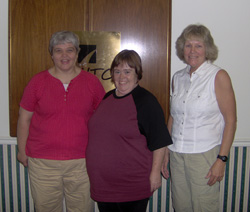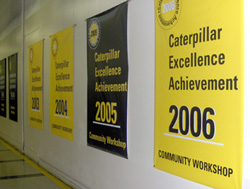
More important than rising numbers are the success stories of individuals who have overcome difficulties to enjoy life to its fullest. The Peoria Woman caught up with three deserving women whose inspiring growth is a reminder that independence is worth fighting for.
CWTC is not just a building on University Street, points out Associate Executive Director of Community Services Patti Gratton. A multi-faceted, non-profit organization, CWTC includes multiple residential areas, an in-house workshop, job placement in the community, small classes and community integration. Almost anyone age 16 or older with a documented disability, whether physical, mental or developmental, can be referred to the organization.
The first step to independence is holding a job, and work contracts at CWTC placed more than $1.5 million into their clients’ pockets in 2006. (This figure does not include the salary of any staff members.) Nearly 350 people complete tasks within the center’s workshop, a large industrial area directly connected to support staff. Contracts with community suppliers, most notably Caterpillar, Inc., hold workers to the same standards as any for-profit facility, says Associate Executive Director of Vocational Services Jim Simkins.
Counting, weighing and packaging parts may seem like tedious work to some, but its importance cannot be denied. Not only does it offer a “reason to get up and go in the morning,” says Leiby, but it settles a sense of productivity and pride on those who work. In connection with the Morton Caterpillar facility, parts are packaged in two shifts, the lengths of which vary according to individuals.
One woman, Tonya, is a thriving example of the difference a job can make in a person’s life. For three years in a row, Tonya has helped CWTC earn the Caterpillar Excellence Achievement Award—an award not exclusive to nonprofit companies, but one extended to deserving facilities internationally.
Before she came to CWTC, Tonya says with a smile that she was just “sitting around.” She and her mother were active in Special Olympics, and when her mother heard about CWTC from a friend, Tonya joined. Seven years later, this independent woman has her father drop her off at the center half an hour early so she can visit with friends and prepare for the workday.
Working as a table aide, Tonya acts almost as a table supervisor—keeping track of who needs what parts so that workers always have the supplies they require. In addition to her work, Tonya serves on One Voice, a type of “student council” where her peers elect her to represent them and their rights. Another example of how CWTC teaches clients to be responsible and stand up for themselves, One Voice allows clients’ ideas to be heard.
Serving on the Safety Committee is another responsibility of Tonya’s. Meeting every month, both employees and clients discuss safety hazards, incidents on the floor and how to keep workers out of harm’s way. Behind Tonya’s shy smile is a bright mind that is actively involved in every aspect of CWTC.
Her favorite things about CWTC are her friends there and the people she works for—not to mention payday! Simkins explained that payment is based on prevailing wage studies the CWTC performs under guidelines from the U.S. and Illinois Departments of Labor. They complete a survey of what other non-disabled companies in the area are paying for the same type of work. Then, the CWTC compares the output of its own programs and the outside sources. Based on the prevailing wage of these non-disabled workers, CWTC employees are paid the same wage percentage (compared to the source) as the percentage of work they complete. Those who work for Caterpillar are paid by the number of parts they package.
Working in the CWTC also means paid time off, vacation time and benefi ts. For Tonya, it means she can indulge her favorite hobbies: shopping and doing crafts. It helps her to take care of six special family members: her three dogs and three cats. She also loves to draw and write.
Nearly 100 workers are also employed outside CWTC in the community. Contacts with the Federal Building in downtown Peoria, the 182nd National Air Guard and others advance the center toward its goal of integration. According to the Center’s 2006 annual report, 81 percent of those working in the community retained their positions after a year.
“The general public is very receptive—they don’t relate to (the workers) as people with disabilities, but just as other people in the workforce,” Simkins said, regarding their presence within the community. “We’re empowering our consumers during the rehabilitation program, but even more when we assist them in fi nding jobs in the community. They become functioning members of society, earning benefi ts, paying taxes…it’s a return to the community rather than a draw.”
Jim Beuster, who became familiar with CWTC at the Chamber of Commerce Community Leadership School, was encouraged by how well the clients do with CWTC’s support. “What makes it such a powerful organization is that they provide opportunities for disabled individuals to work in the real world and coach them on how to live as normal a life as possible,” he said. “A living example is Tonya…it speaks a lot of CWTC, that they can give her an opportunity like that—that she can be part of such a wonderful award.”
 Laurie is another woman who joined the center looking for independence. A high school graduate, she has been employed at the Peoria Production Center for a year and a half, doing many of the same tasks she did at the CWTC. Because the center is located away from CWTC, the level of independence rises for those who are employed there.
Laurie is another woman who joined the center looking for independence. A high school graduate, she has been employed at the Peoria Production Center for a year and a half, doing many of the same tasks she did at the CWTC. Because the center is located away from CWTC, the level of independence rises for those who are employed there.
Unlike Tonya, Laurie does not live at home but takes advantage of another aspect of CWTC. In her independent living apartment, Laurie is responsible for a bedroom, kitchen, living room and bathroom. She smiled and admitted she mostly cooked microwavable dinners, but her upbeat sense of humor has given her an enjoyable experience living on her own.
“It’s kind of nice being out on my own. I can leave my room whenever I want,” she said. Speaking of CWTC, she said, “It’s a great place to come to learn about being in the community and living on your own.”
Gratton explained the four levels of housing that CWTC coordinates: places ranging from 24-hour supervision to renting single-family homes with support as needed. At each location, residents focus on different skills, including how to do laundry, access public transportation and stick to a budget. The system is flexible and successful, as indicated by the waiting lists for each of the facilities.
Despite the waiting period, Gratton emphasized that families of disabled people should plan ahead: “It’s important for families to plan for their loved ones vocationally and residentially…just like you’d plan for your own future, plan for their future, too,” she said. “We come up with individualized program plans, setting goals for the year, short-term and long-term, and family members and friends can plan for the future, too.”
In addition to housing and employment, recreational activities are important to all of the people at CWTC. Leiby shared that just by making trips to the grocery store or seeing a movie, disabled people can join the surrounding community and work on breaking down “attitudinal barriers” that exist.
Laurie’s favorite craft—making necklaces and bracelets—has drawn her into the community and increased her independence. Last year she made and entered several pieces of jewelry into the Heart of Illinois Fair, winning first place in the necklace category and third place in the bracelet category.
In the spirit of giving back to the community that has supported them, Gratton encourages clients to volunteer through a program called Community Integration. Every Friday morning, groups clean at Luthy Botanical Gardens; two days a week from April to October, clients serve as volunteer guides at Wildlife Prairie State Park. During the winter season, the Salvation Army is gifted with quite a few bell-ringers from CWTC. Anyone who wants to participate is given as many opportunities as possible.
A final and powerful example of growth is Kathy, a woman who has been with CWTC for seven years. Like Laurie, Kathy has her own apartment and a favorite hobby: bird-watching. By visiting parks and hanging her own birdfeeders, she has come to recognize several species and their calls. She describes her favorite, a cedar waxwing, as having “the crest of a cardinal but with more colors.”
Employed at the CWTC, Kathy is pursuing the heartwarming goal of becoming a staff member instead of a consumer, and she’s not that far from achieving it. After first packaging the parts before becoming a table aide two years ago, she now calls herself an “unofficial assistant” to her crew chief. Giving up her day off was a sign of how serious her goal is, and she said with quiet pride that she had progressed in the job, learning more details. At CWTC, dreams become reality.
Kathy also serves on a third CWTC committee— the Human Rights Committee. Connected with the Board of Directors, Kathy described her position: “I attend meetings as a liaison for consumers to the board members for anything they might or I might see that needs to be brought to attention,” she said.
Her ambitions are even more astonishing when compared to the person she was before she came to CWTC. “Before I came to CWTC I was kind of isolated; I didn’t do much,” she said. “I would go to the Human Service Center for some groups for something to do, but I heard from people in my groups there that you can work at CWTC.
“Specifically, one of the things that CWTC has done for me is put structure in my life so that I could start changing my lifestyle. For instance, I quit smoking, exercise, eat right (and) I lost a lot of weight. I’ve put myself in better health and have more goals.”
While touring CWTC, it became obvious that these three women are not in the minority; kind, considerate people were everywhere. A man named Art on the work floor talked about his upcoming flight to New York City to see the Statue of Liberty. One woman watched out for others so they wouldn’t be standing in harm’s way. Staff members were friendly and open; their passion for their work was quite evident.
The support of CWTC is not tucked away on University Street, but is growing in the hearts of those who have been helped by or contribute to the center’s services.
“I’ve been in many different levels of social services over the last 35 years, but this is the most rewarding,” Simkins shared. “It’s so exciting to see consumers grow even after they leave our services. It’s giving them empowerment and self-esteem. They can achieve many things that people without disabilities can.” TPW
